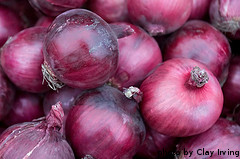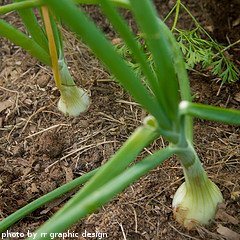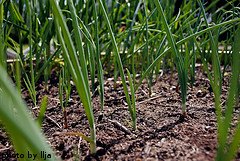Questions About Growing Onions?
Growing onions has become a tradition for many backyard vegetable gardeners. They are easy to plant, maintain and harvest. Growing your own onions is also economical. A typical onion seed packet might cost two dollars and is capable of producing dozens of onions. By growing your own, you also have a lot more varieties to choose from than you might find in your local grocery store. Once harvested, onions can be stored for several months as is, or chopped up and frozen until ready to use. If you like to cook, you know that onions are used as an ingredient in thousands of recipes.

Onions generally come in white, yellow, and red varieties. These varieties will vary greatly in taste, from mild and sweet to strong and pungent. You can also get green onions (scallions) by harvesting immature onion plants, before the bulb begins to enlarge. Additionally, if you are interested in growing only scallions, try bunching onion varieties. Bunching onions never develop a bulb and are grown exclusively to be used as scallions.

Depending on your climate, onions are planted at different times of the year. Your climate will also dictate the type of onion you grow. There are two main types of onions -short day and long day. Short day varieties are mainly grown in warmer climates during the winter time. These types of onions do best when there are about 12 hours of daylight. Long day varieties are grown in colder regions and do best when daylight hours extend to 15-16 hours. In very warm climates with mild winters, most folks plant short-day onion varieties in the fall. In cooler climates, long-day onion varieties are planted in the early spring, as soon as the soil is workable. Typically, onions are a cooler season crop and do not do well in very hot weather. If you are in doubt about when to plant onions, you'll probably be better off starting in the early spring.
When growing onions, the soil should be loose and airy to a depth of 8 inches. Additionally, the soil should drain well. If the soil stays waterlogged, the onions will rot before they have a chance to grow. Also, they should be planted in a spot that gets 6-8 hours of direct sunlight daily. Onions are also an excellent choice for container gardening because they don't take up much space.
Onions can be used in a wide variety of recipes. They can be fried, sauteed, roasted and eaten raw on sandwiches or in salads. Additionally, onions are used to flavor lots of different sauces and soups. Onions are packed with vitamins and minerals and also contain quercitin, a potent antioxidant. To learn more about the health benefits of onions and lots of other foods, visit foods-healing-power.com. They have lots of great information about using different foods to naturally heal your body, mind and soul.
Click on the following links to learn more about growing onions.

Click here to learn about planting onions
Click here to learn about fertilizing and watering onions
Click here to learn about harvesting onions
Click here for information about different onion varieties
Click here for some of our favorite onion recipes
Click here to move from our Growing Onions page to our Home page